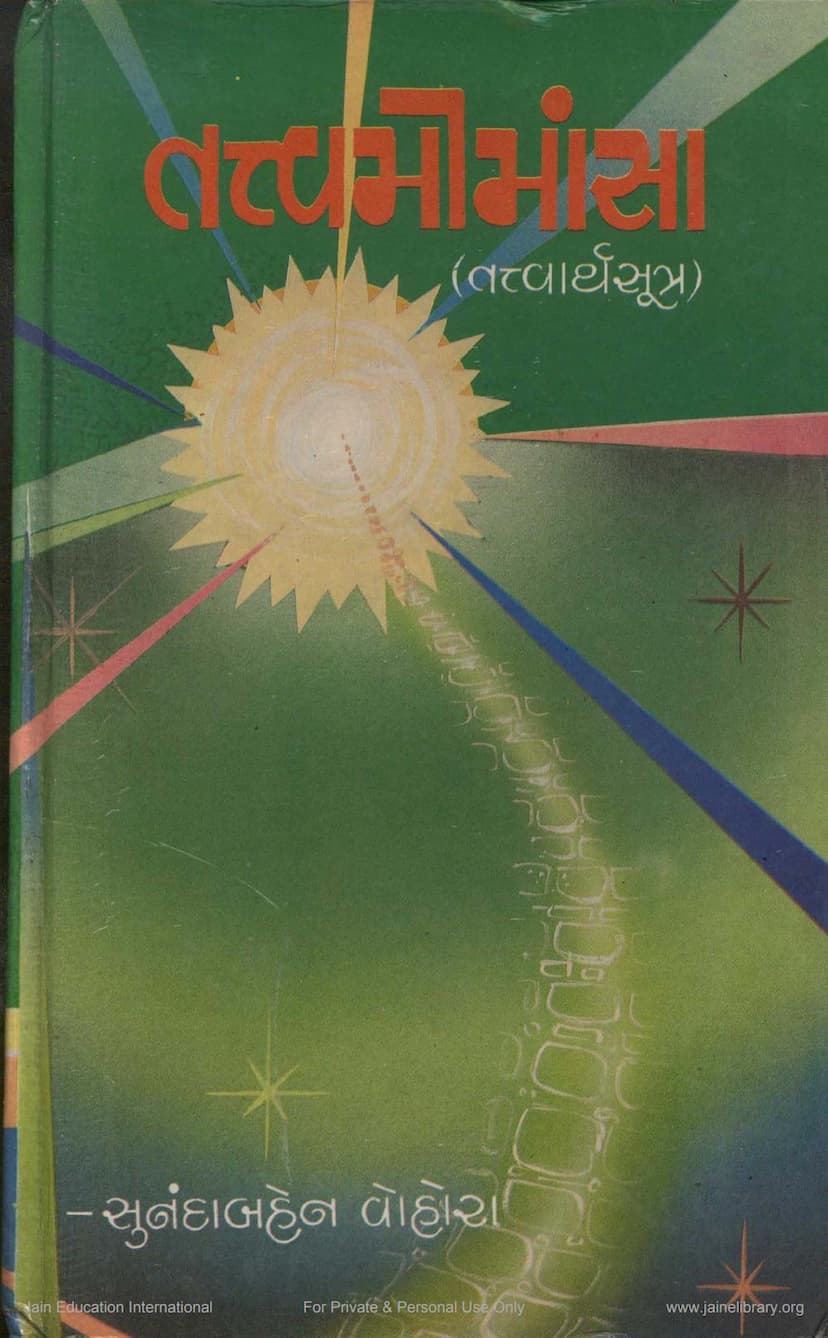Tattvamimansa
Added to library: September 2, 2025

Summary
This is a comprehensive summary of the Jain text "Tattvamimansa" by Sunandaben Vohra, based on the provided catalog link and text content.
Book Title: Tattvamimansa (also referred to as Tattvarthasutra Sar) Author: Sunandaben Vohra Publisher: Nilaben and Ashokbhai Choksi Catalog Link: https://jainqq.org/explore/004528/1
Overall Summary:
"Tattvamimansa" is a Gujarati commentary and elaboration on the foundational Jain scripture, the Tattvarthasutra, authored by Acharya Umaswati. The book aims to present the profound and complex principles of Jain philosophy in a simplified and accessible manner for the common reader. Sunandaben Vohra, the editor, expresses her intention to make this invaluable text available to a wider audience, particularly those who may find the original Tattvarthasutra challenging. The book meticulously explains the fundamental Jain teachings, covering a vast spectrum of concepts from the nature of reality (dravyanuyoga) to the principles of karma (karananuyoga) and ethical conduct (charanannuyoga).
Key Themes and Content:
The book follows the structure of the Tattvarthasutra, systematically explaining each chapter and verse. Here's a breakdown of the key themes covered across the chapters, as indicated by the table of contents and the provided text snippets:
-
Core Jain Philosophy (Tattvas): The central focus is on the seven foundational tattvas (realities) of Jainism:
- Jiva (Soul): Explores the nature of the soul, its attributes, its transmigration, and the types of souls.
- Ajiva (Non-Soul): Details the categories of non-living substances, including dharma, adharma, dharma, pudgala, and akasha.
- Asrava (Influx of Karma): Explains the channels through which karma enters the soul, caused by sensory pleasures and passions.
- Bandha (Bondage of Karma): Describes how karma attaches to the soul and the reasons for this bondage.
- Samvara (Stoppage of Karma): Outlines the practices and principles that prevent new karma from binding to the soul, such as the five samitis and three guptis.
- Nirjara (Shedding of Karma): Explains the process of karmic purification through austerities and spiritual practices.
- Moksha (Liberation): Describes the ultimate goal of Jainism – the state of liberation from the cycle of birth and death, characterized by the soul's perfect knowledge, perception, bliss, and power.
-
Knowledge (Jñana): The book delves into the different types of knowledge:
- Mati Jñana (Sense-based Knowledge): Explained through the four stages: Avagraha,oha, Apaya, and Dharana.
- Shruta Jñana (Scriptural Knowledge): Knowledge gained through scriptures and teachings.
- Avadhi Jñana (Clairvoyance): Knowledge of subtle objects within a limited range.
- Manahparyaya Jñana (Telepathy): Knowledge of the thoughts of others.
- Kevala Jñana (Omniscience): The absolute and complete knowledge possessed by the liberated soul.
-
The Path to Liberation (Moksha Marga): The book emphasizes the triad of Samyak Darshan (Right Faith/Perception), Samyak Jñana (Right Knowledge), and Samyak Charitra (Right Conduct) as the indispensable path to Moksha.
- Samyak Darshan: Right faith in the tattvas, faith in the teachings of the Tirthankaras, and the absence of misconceptions (mithyatva). The book elaborates on the characteristics of Samyak Darshan like Shama (tranquility), Samvega (awe/enthusiasm for liberation), etc.
- Samyak Jñana: Right knowledge that accurately understands the nature of reality.
- Samyak Charitra: Right conduct that aligns with right knowledge and faith, involving the practice of vows and ethical principles.
-
Karma Theory: A significant portion is dedicated to explaining the intricate theory of karma, including:
- The nature of karma as subtle, karma-forming substances (pudgala).
- The eightfold classification of karma (Jnanavaraniya, Darshanavaraniya, Vedaniya, Mohaniya, Ayushya, Nama, Gotra, Antaraya) and their specific functions.
- The various types and subtypes of karmas and how they manifest.
- The causes of karmic bondage and the process of shedding karma (Nirjara).
-
Cosmology and Geography: The text provides detailed descriptions of the Jain universe (Loka):
- The Three Lokas: Adholoka (lower world), Madhyaloka (middle world), and Urdhva Loka (upper world).
- The Seven Naraka Lokas (Hells): Descriptions of the hellish realms, their inhabitants, their suffering, and the conditions.
- The Middle World: Detailed descriptions of the continents (dvipas) and oceans, including Jambudvipa, the central continent with Mount Meru, and its various regions (karmabhumi and akarmabhumi).
- The Upper World (Deva Lokas): Descriptions of the celestial realms, including Bhavanapatis, Vyantaras, Jyotishkas (celestial bodies), and Vaimanikas (gods residing in palaces), their various classes, lifespans, pleasures, and locations.
-
Ethical Conduct and Practices:
- Vows (Vratas): Explains the five Mahavratas for ascetics and the five Anuvratas and seven Gunavratas/Shikshavratas for lay followers.
- Austerities (Tapa): Details the classifications of external and internal austerities that aid in karmic purification.
- The Six Essential Substances (Dravyas): Provides an exposition of Jiva, Ajiva, Asrava, Bandha, Samvara, Nirjara, Moksha, and also Pudgala with its various forms like Skandhas, Desha, Pradesh, and Paramāṇu.
- Nayas and Pramanas: Explains the epistemological principles of Jain logic used to understand realities.
-
Commentary Style: Sunandaben Vohra highlights that her work is primarily a compilation, drawing heavily from previous commentaries and scholarly works, particularly those by Pandit Sukhlalji and Muni Rajshekhar Vijayji. She aims for clarity and simplicity, making the teachings accessible to a broad audience. The text includes detailed explanations of Sutras, often breaking down compound words and providing cross-references.
Purpose and Audience:
The book is intended for a Gujarati-speaking audience interested in understanding the core tenets of Jainism. It serves as an educational resource for students and practitioners of Jainism who wish to deepen their knowledge of the Tattvarthasutra and its philosophical underpinnings. The editor's humble request for the book to be returned promptly after use underscores its circulation for the benefit of the Jain community.
Overall Impression:
"Tattvamimansa" appears to be a scholarly yet devotional endeavor to elucidate the Tattvarthasutra. It showcases the author's dedication to Jain philosophy and her commitment to making these teachings understandable and impactful. The detailed breakdown of concepts reflects a thorough approach to explaining the Jain path to liberation.